University Case Study: Exacerbation of Systolic Heart Failure
VerifiedAdded on 2022/09/22
|8
|1870
|25
Case Study
AI Summary
This case study examines a patient admitted to the emergency department with severe dyspnea and symptoms indicative of an exacerbation of chronic systolic heart failure. The assignment details the patient's presentation, including elevated respiratory rate, decreased oxygen saturation, high blood pressure, increased heart rate, and atrial fibrillation on the ECG. The pathophysiology of chronic systolic heart failure is explained, emphasizing the body's compensatory mechanisms and the resulting myocardial damage. The study further outlines two crucial nursing strategies: vigilant monitoring of vital signs and the administration of medications, including furosemide and glyceryl trinitrate. Furosemide is highlighted for its diuretic action, while glyceryl trinitrate is discussed for its vasodilator properties, reducing ventricular filling pressure. The assignment concludes with a list of relevant references.
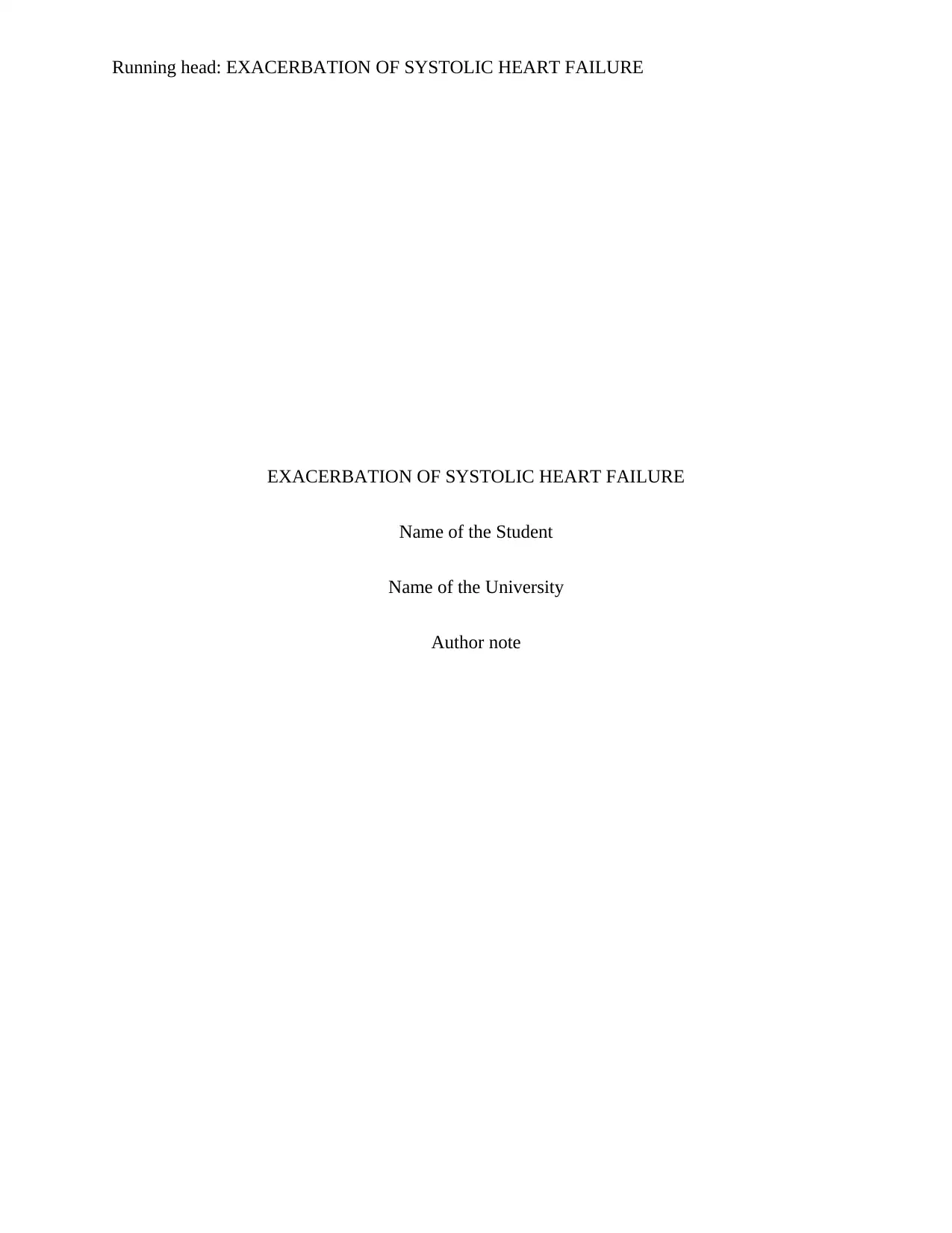
Running head: EXACERBATION OF SYSTOLIC HEART FAILURE
EXACERBATION OF SYSTOLIC HEART FAILURE
Name of the Student
Name of the University
Author note
EXACERBATION OF SYSTOLIC HEART FAILURE
Name of the Student
Name of the University
Author note
Paraphrase This Document
Need a fresh take? Get an instant paraphrase of this document with our AI Paraphraser
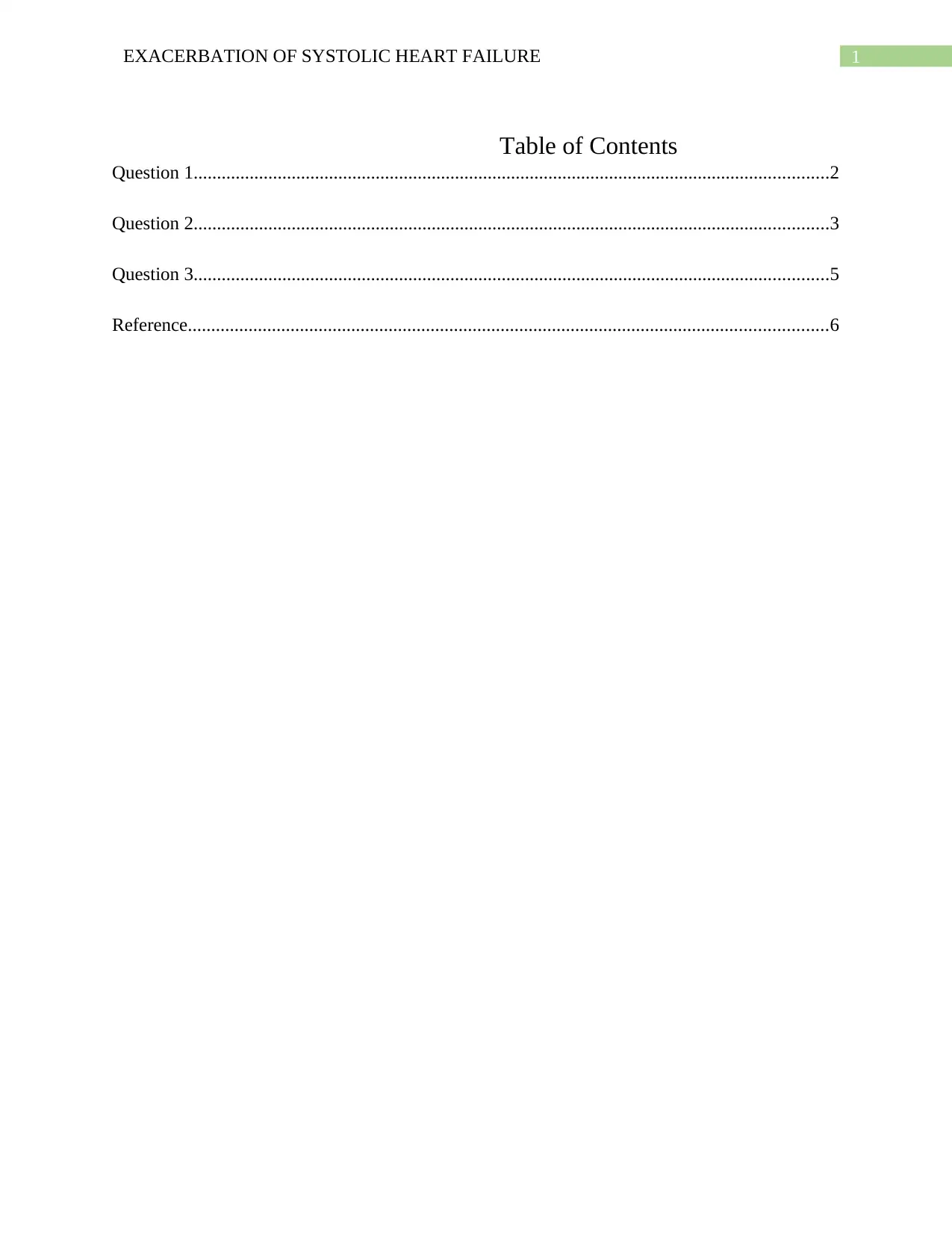
1EXACERBATION OF SYSTOLIC HEART FAILURE
Table of Contents
Question 1........................................................................................................................................2
Question 2........................................................................................................................................3
Question 3........................................................................................................................................5
Reference.........................................................................................................................................6
Table of Contents
Question 1........................................................................................................................................2
Question 2........................................................................................................................................3
Question 3........................................................................................................................................5
Reference.........................................................................................................................................6
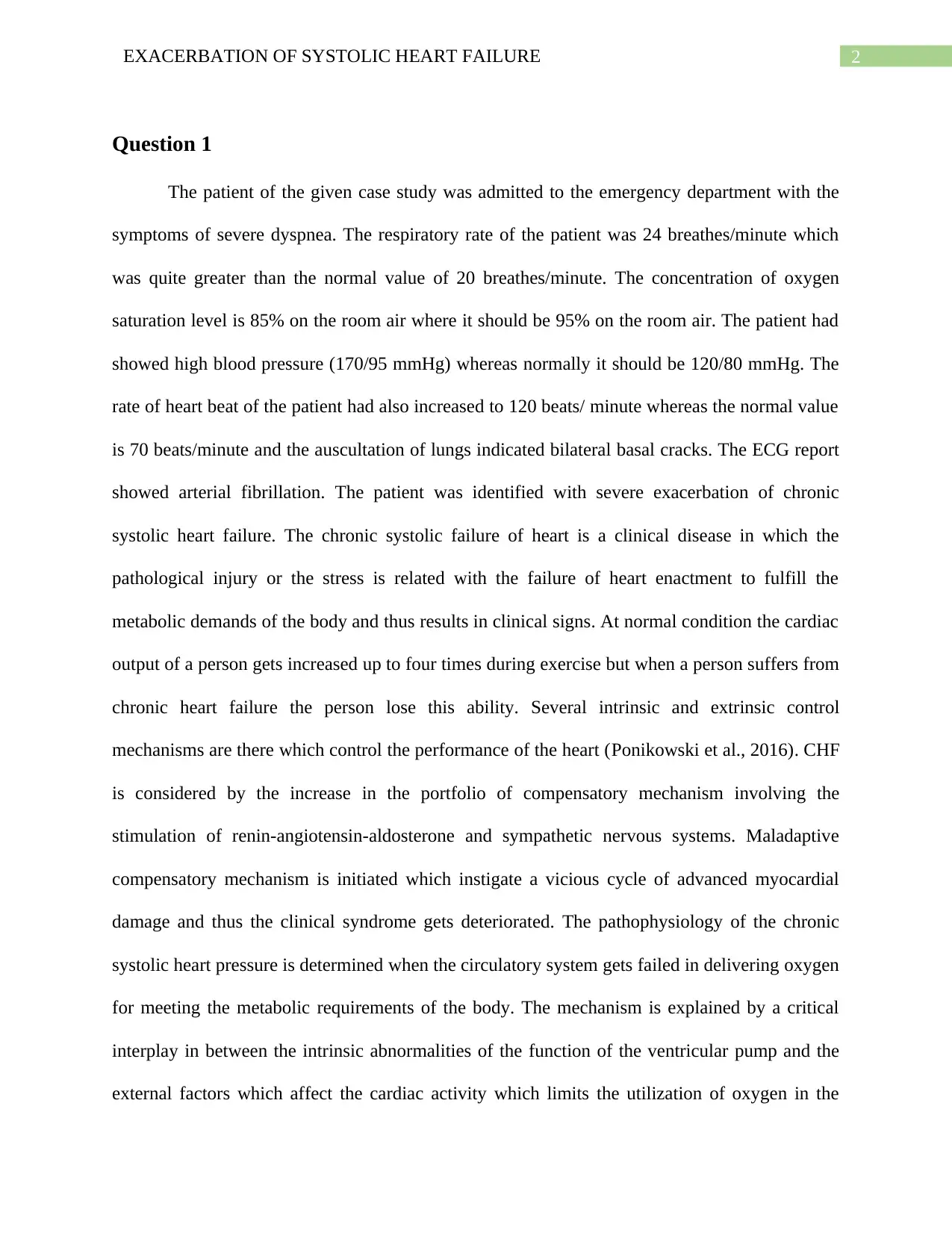
2EXACERBATION OF SYSTOLIC HEART FAILURE
Question 1
The patient of the given case study was admitted to the emergency department with the
symptoms of severe dyspnea. The respiratory rate of the patient was 24 breathes/minute which
was quite greater than the normal value of 20 breathes/minute. The concentration of oxygen
saturation level is 85% on the room air where it should be 95% on the room air. The patient had
showed high blood pressure (170/95 mmHg) whereas normally it should be 120/80 mmHg. The
rate of heart beat of the patient had also increased to 120 beats/ minute whereas the normal value
is 70 beats/minute and the auscultation of lungs indicated bilateral basal cracks. The ECG report
showed arterial fibrillation. The patient was identified with severe exacerbation of chronic
systolic heart failure. The chronic systolic failure of heart is a clinical disease in which the
pathological injury or the stress is related with the failure of heart enactment to fulfill the
metabolic demands of the body and thus results in clinical signs. At normal condition the cardiac
output of a person gets increased up to four times during exercise but when a person suffers from
chronic heart failure the person lose this ability. Several intrinsic and extrinsic control
mechanisms are there which control the performance of the heart (Ponikowski et al., 2016). CHF
is considered by the increase in the portfolio of compensatory mechanism involving the
stimulation of renin-angiotensin-aldosterone and sympathetic nervous systems. Maladaptive
compensatory mechanism is initiated which instigate a vicious cycle of advanced myocardial
damage and thus the clinical syndrome gets deteriorated. The pathophysiology of the chronic
systolic heart pressure is determined when the circulatory system gets failed in delivering oxygen
for meeting the metabolic requirements of the body. The mechanism is explained by a critical
interplay in between the intrinsic abnormalities of the function of the ventricular pump and the
external factors which affect the cardiac activity which limits the utilization of oxygen in the
Question 1
The patient of the given case study was admitted to the emergency department with the
symptoms of severe dyspnea. The respiratory rate of the patient was 24 breathes/minute which
was quite greater than the normal value of 20 breathes/minute. The concentration of oxygen
saturation level is 85% on the room air where it should be 95% on the room air. The patient had
showed high blood pressure (170/95 mmHg) whereas normally it should be 120/80 mmHg. The
rate of heart beat of the patient had also increased to 120 beats/ minute whereas the normal value
is 70 beats/minute and the auscultation of lungs indicated bilateral basal cracks. The ECG report
showed arterial fibrillation. The patient was identified with severe exacerbation of chronic
systolic heart failure. The chronic systolic failure of heart is a clinical disease in which the
pathological injury or the stress is related with the failure of heart enactment to fulfill the
metabolic demands of the body and thus results in clinical signs. At normal condition the cardiac
output of a person gets increased up to four times during exercise but when a person suffers from
chronic heart failure the person lose this ability. Several intrinsic and extrinsic control
mechanisms are there which control the performance of the heart (Ponikowski et al., 2016). CHF
is considered by the increase in the portfolio of compensatory mechanism involving the
stimulation of renin-angiotensin-aldosterone and sympathetic nervous systems. Maladaptive
compensatory mechanism is initiated which instigate a vicious cycle of advanced myocardial
damage and thus the clinical syndrome gets deteriorated. The pathophysiology of the chronic
systolic heart pressure is determined when the circulatory system gets failed in delivering oxygen
for meeting the metabolic requirements of the body. The mechanism is explained by a critical
interplay in between the intrinsic abnormalities of the function of the ventricular pump and the
external factors which affect the cardiac activity which limits the utilization of oxygen in the
⊘ This is a preview!⊘
Do you want full access?
Subscribe today to unlock all pages.

Trusted by 1+ million students worldwide
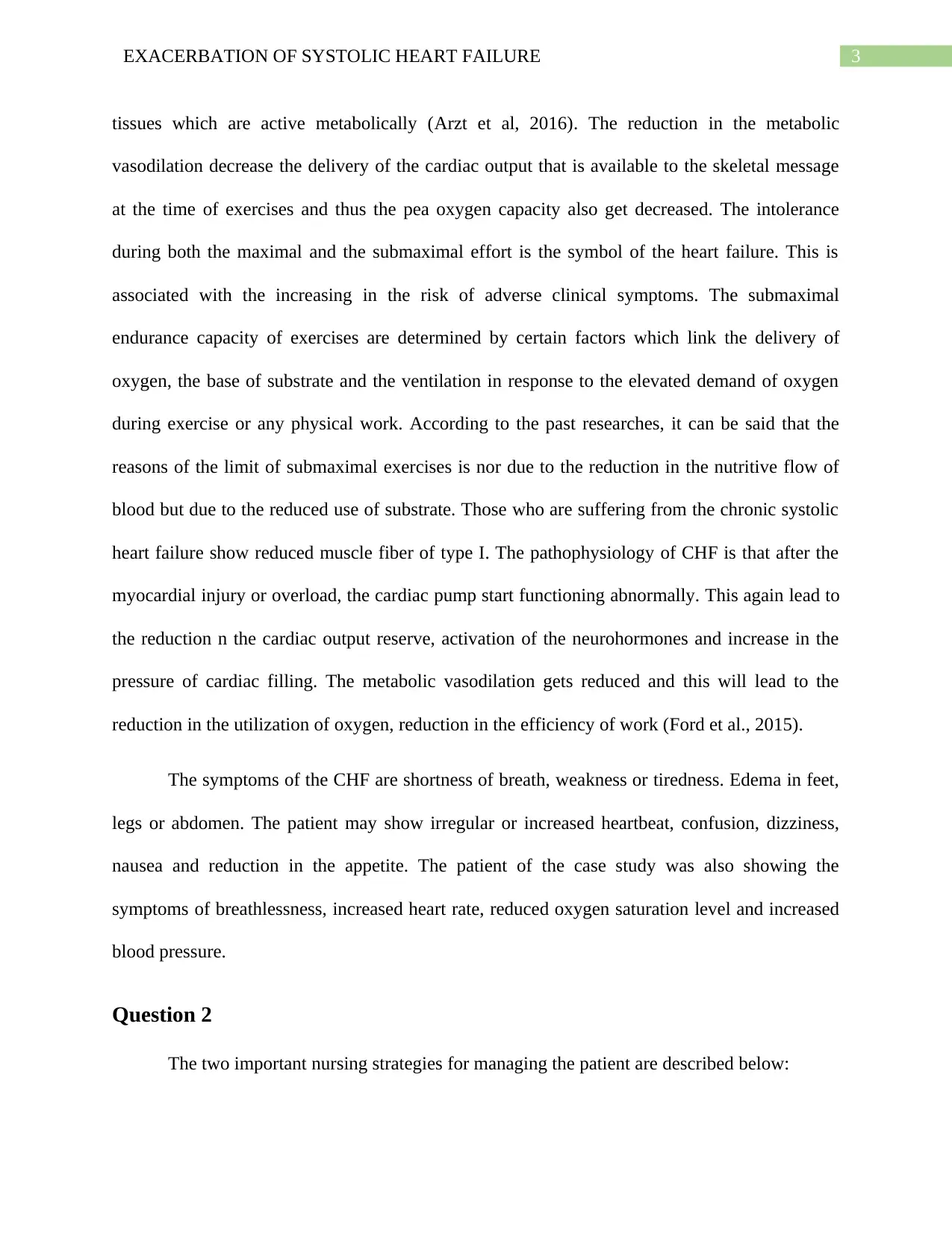
3EXACERBATION OF SYSTOLIC HEART FAILURE
tissues which are active metabolically (Arzt et al, 2016). The reduction in the metabolic
vasodilation decrease the delivery of the cardiac output that is available to the skeletal message
at the time of exercises and thus the pea oxygen capacity also get decreased. The intolerance
during both the maximal and the submaximal effort is the symbol of the heart failure. This is
associated with the increasing in the risk of adverse clinical symptoms. The submaximal
endurance capacity of exercises are determined by certain factors which link the delivery of
oxygen, the base of substrate and the ventilation in response to the elevated demand of oxygen
during exercise or any physical work. According to the past researches, it can be said that the
reasons of the limit of submaximal exercises is nor due to the reduction in the nutritive flow of
blood but due to the reduced use of substrate. Those who are suffering from the chronic systolic
heart failure show reduced muscle fiber of type I. The pathophysiology of CHF is that after the
myocardial injury or overload, the cardiac pump start functioning abnormally. This again lead to
the reduction n the cardiac output reserve, activation of the neurohormones and increase in the
pressure of cardiac filling. The metabolic vasodilation gets reduced and this will lead to the
reduction in the utilization of oxygen, reduction in the efficiency of work (Ford et al., 2015).
The symptoms of the CHF are shortness of breath, weakness or tiredness. Edema in feet,
legs or abdomen. The patient may show irregular or increased heartbeat, confusion, dizziness,
nausea and reduction in the appetite. The patient of the case study was also showing the
symptoms of breathlessness, increased heart rate, reduced oxygen saturation level and increased
blood pressure.
Question 2
The two important nursing strategies for managing the patient are described below:
tissues which are active metabolically (Arzt et al, 2016). The reduction in the metabolic
vasodilation decrease the delivery of the cardiac output that is available to the skeletal message
at the time of exercises and thus the pea oxygen capacity also get decreased. The intolerance
during both the maximal and the submaximal effort is the symbol of the heart failure. This is
associated with the increasing in the risk of adverse clinical symptoms. The submaximal
endurance capacity of exercises are determined by certain factors which link the delivery of
oxygen, the base of substrate and the ventilation in response to the elevated demand of oxygen
during exercise or any physical work. According to the past researches, it can be said that the
reasons of the limit of submaximal exercises is nor due to the reduction in the nutritive flow of
blood but due to the reduced use of substrate. Those who are suffering from the chronic systolic
heart failure show reduced muscle fiber of type I. The pathophysiology of CHF is that after the
myocardial injury or overload, the cardiac pump start functioning abnormally. This again lead to
the reduction n the cardiac output reserve, activation of the neurohormones and increase in the
pressure of cardiac filling. The metabolic vasodilation gets reduced and this will lead to the
reduction in the utilization of oxygen, reduction in the efficiency of work (Ford et al., 2015).
The symptoms of the CHF are shortness of breath, weakness or tiredness. Edema in feet,
legs or abdomen. The patient may show irregular or increased heartbeat, confusion, dizziness,
nausea and reduction in the appetite. The patient of the case study was also showing the
symptoms of breathlessness, increased heart rate, reduced oxygen saturation level and increased
blood pressure.
Question 2
The two important nursing strategies for managing the patient are described below:
Paraphrase This Document
Need a fresh take? Get an instant paraphrase of this document with our AI Paraphraser
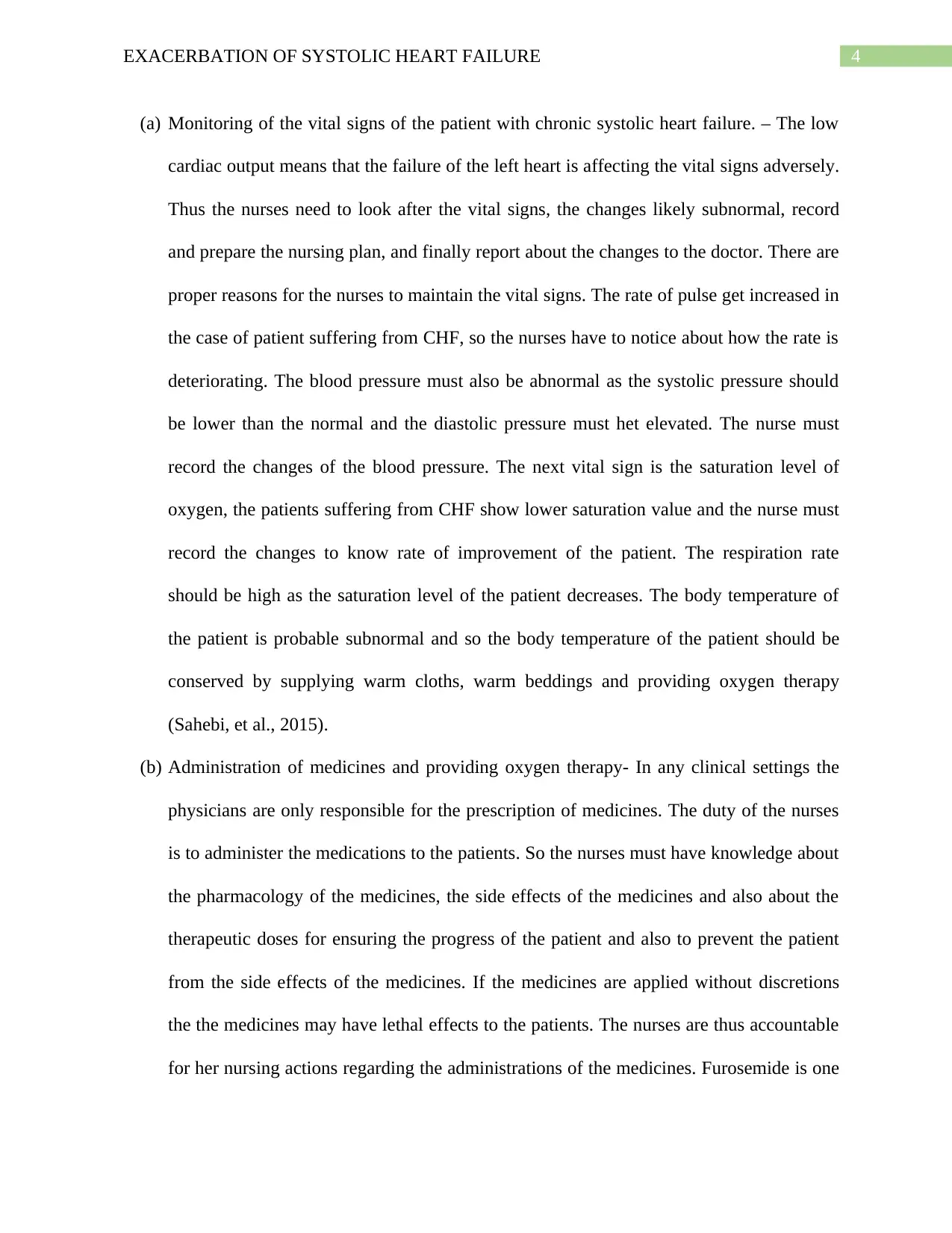
4EXACERBATION OF SYSTOLIC HEART FAILURE
(a) Monitoring of the vital signs of the patient with chronic systolic heart failure. – The low
cardiac output means that the failure of the left heart is affecting the vital signs adversely.
Thus the nurses need to look after the vital signs, the changes likely subnormal, record
and prepare the nursing plan, and finally report about the changes to the doctor. There are
proper reasons for the nurses to maintain the vital signs. The rate of pulse get increased in
the case of patient suffering from CHF, so the nurses have to notice about how the rate is
deteriorating. The blood pressure must also be abnormal as the systolic pressure should
be lower than the normal and the diastolic pressure must het elevated. The nurse must
record the changes of the blood pressure. The next vital sign is the saturation level of
oxygen, the patients suffering from CHF show lower saturation value and the nurse must
record the changes to know rate of improvement of the patient. The respiration rate
should be high as the saturation level of the patient decreases. The body temperature of
the patient is probable subnormal and so the body temperature of the patient should be
conserved by supplying warm cloths, warm beddings and providing oxygen therapy
(Sahebi, et al., 2015).
(b) Administration of medicines and providing oxygen therapy- In any clinical settings the
physicians are only responsible for the prescription of medicines. The duty of the nurses
is to administer the medications to the patients. So the nurses must have knowledge about
the pharmacology of the medicines, the side effects of the medicines and also about the
therapeutic doses for ensuring the progress of the patient and also to prevent the patient
from the side effects of the medicines. If the medicines are applied without discretions
the the medicines may have lethal effects to the patients. The nurses are thus accountable
for her nursing actions regarding the administrations of the medicines. Furosemide is one
(a) Monitoring of the vital signs of the patient with chronic systolic heart failure. – The low
cardiac output means that the failure of the left heart is affecting the vital signs adversely.
Thus the nurses need to look after the vital signs, the changes likely subnormal, record
and prepare the nursing plan, and finally report about the changes to the doctor. There are
proper reasons for the nurses to maintain the vital signs. The rate of pulse get increased in
the case of patient suffering from CHF, so the nurses have to notice about how the rate is
deteriorating. The blood pressure must also be abnormal as the systolic pressure should
be lower than the normal and the diastolic pressure must het elevated. The nurse must
record the changes of the blood pressure. The next vital sign is the saturation level of
oxygen, the patients suffering from CHF show lower saturation value and the nurse must
record the changes to know rate of improvement of the patient. The respiration rate
should be high as the saturation level of the patient decreases. The body temperature of
the patient is probable subnormal and so the body temperature of the patient should be
conserved by supplying warm cloths, warm beddings and providing oxygen therapy
(Sahebi, et al., 2015).
(b) Administration of medicines and providing oxygen therapy- In any clinical settings the
physicians are only responsible for the prescription of medicines. The duty of the nurses
is to administer the medications to the patients. So the nurses must have knowledge about
the pharmacology of the medicines, the side effects of the medicines and also about the
therapeutic doses for ensuring the progress of the patient and also to prevent the patient
from the side effects of the medicines. If the medicines are applied without discretions
the the medicines may have lethal effects to the patients. The nurses are thus accountable
for her nursing actions regarding the administrations of the medicines. Furosemide is one
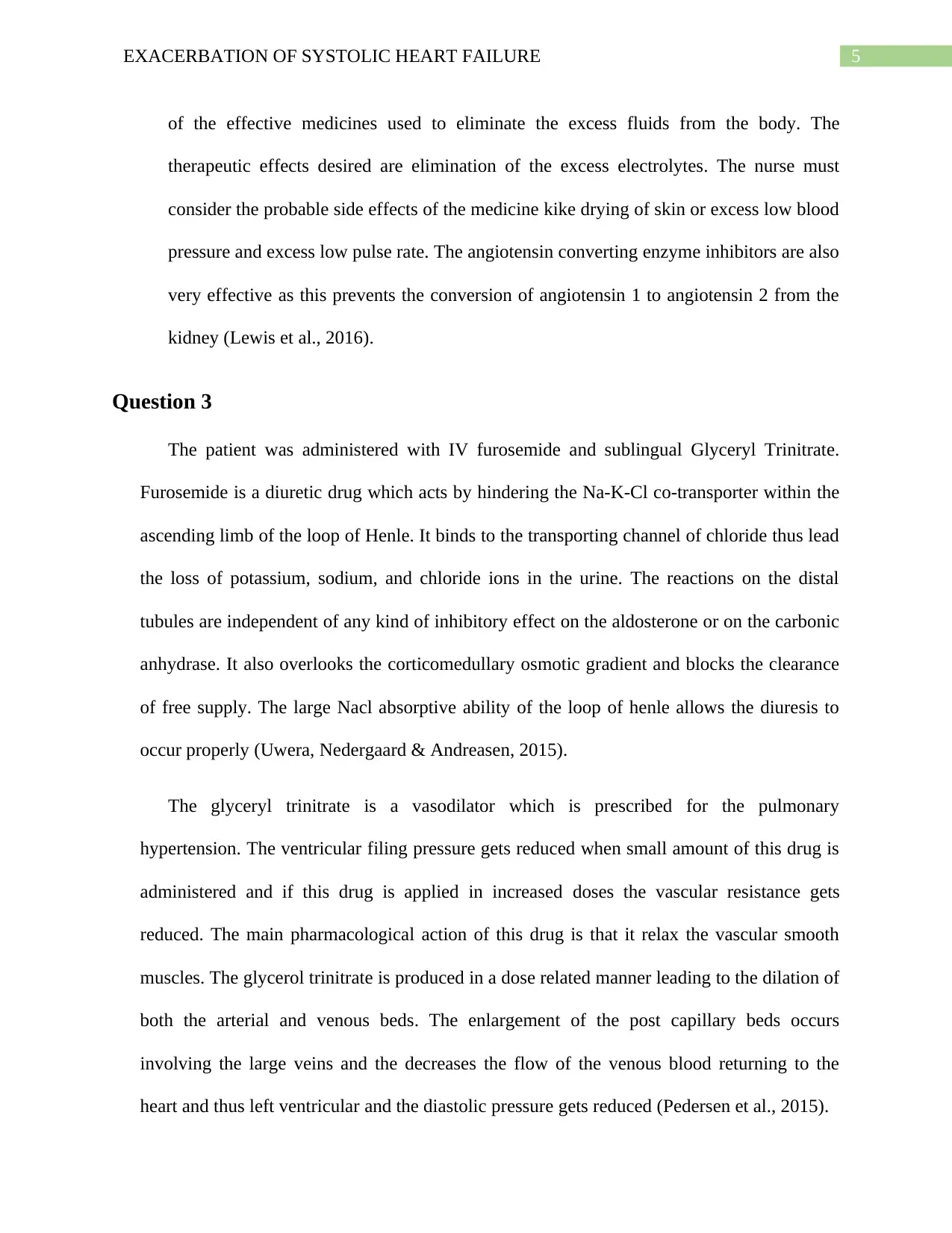
5EXACERBATION OF SYSTOLIC HEART FAILURE
of the effective medicines used to eliminate the excess fluids from the body. The
therapeutic effects desired are elimination of the excess electrolytes. The nurse must
consider the probable side effects of the medicine kike drying of skin or excess low blood
pressure and excess low pulse rate. The angiotensin converting enzyme inhibitors are also
very effective as this prevents the conversion of angiotensin 1 to angiotensin 2 from the
kidney (Lewis et al., 2016).
Question 3
The patient was administered with IV furosemide and sublingual Glyceryl Trinitrate.
Furosemide is a diuretic drug which acts by hindering the Na-K-Cl co-transporter within the
ascending limb of the loop of Henle. It binds to the transporting channel of chloride thus lead
the loss of potassium, sodium, and chloride ions in the urine. The reactions on the distal
tubules are independent of any kind of inhibitory effect on the aldosterone or on the carbonic
anhydrase. It also overlooks the corticomedullary osmotic gradient and blocks the clearance
of free supply. The large Nacl absorptive ability of the loop of henle allows the diuresis to
occur properly (Uwera, Nedergaard & Andreasen, 2015).
The glyceryl trinitrate is a vasodilator which is prescribed for the pulmonary
hypertension. The ventricular filing pressure gets reduced when small amount of this drug is
administered and if this drug is applied in increased doses the vascular resistance gets
reduced. The main pharmacological action of this drug is that it relax the vascular smooth
muscles. The glycerol trinitrate is produced in a dose related manner leading to the dilation of
both the arterial and venous beds. The enlargement of the post capillary beds occurs
involving the large veins and the decreases the flow of the venous blood returning to the
heart and thus left ventricular and the diastolic pressure gets reduced (Pedersen et al., 2015).
of the effective medicines used to eliminate the excess fluids from the body. The
therapeutic effects desired are elimination of the excess electrolytes. The nurse must
consider the probable side effects of the medicine kike drying of skin or excess low blood
pressure and excess low pulse rate. The angiotensin converting enzyme inhibitors are also
very effective as this prevents the conversion of angiotensin 1 to angiotensin 2 from the
kidney (Lewis et al., 2016).
Question 3
The patient was administered with IV furosemide and sublingual Glyceryl Trinitrate.
Furosemide is a diuretic drug which acts by hindering the Na-K-Cl co-transporter within the
ascending limb of the loop of Henle. It binds to the transporting channel of chloride thus lead
the loss of potassium, sodium, and chloride ions in the urine. The reactions on the distal
tubules are independent of any kind of inhibitory effect on the aldosterone or on the carbonic
anhydrase. It also overlooks the corticomedullary osmotic gradient and blocks the clearance
of free supply. The large Nacl absorptive ability of the loop of henle allows the diuresis to
occur properly (Uwera, Nedergaard & Andreasen, 2015).
The glyceryl trinitrate is a vasodilator which is prescribed for the pulmonary
hypertension. The ventricular filing pressure gets reduced when small amount of this drug is
administered and if this drug is applied in increased doses the vascular resistance gets
reduced. The main pharmacological action of this drug is that it relax the vascular smooth
muscles. The glycerol trinitrate is produced in a dose related manner leading to the dilation of
both the arterial and venous beds. The enlargement of the post capillary beds occurs
involving the large veins and the decreases the flow of the venous blood returning to the
heart and thus left ventricular and the diastolic pressure gets reduced (Pedersen et al., 2015).
⊘ This is a preview!⊘
Do you want full access?
Subscribe today to unlock all pages.

Trusted by 1+ million students worldwide
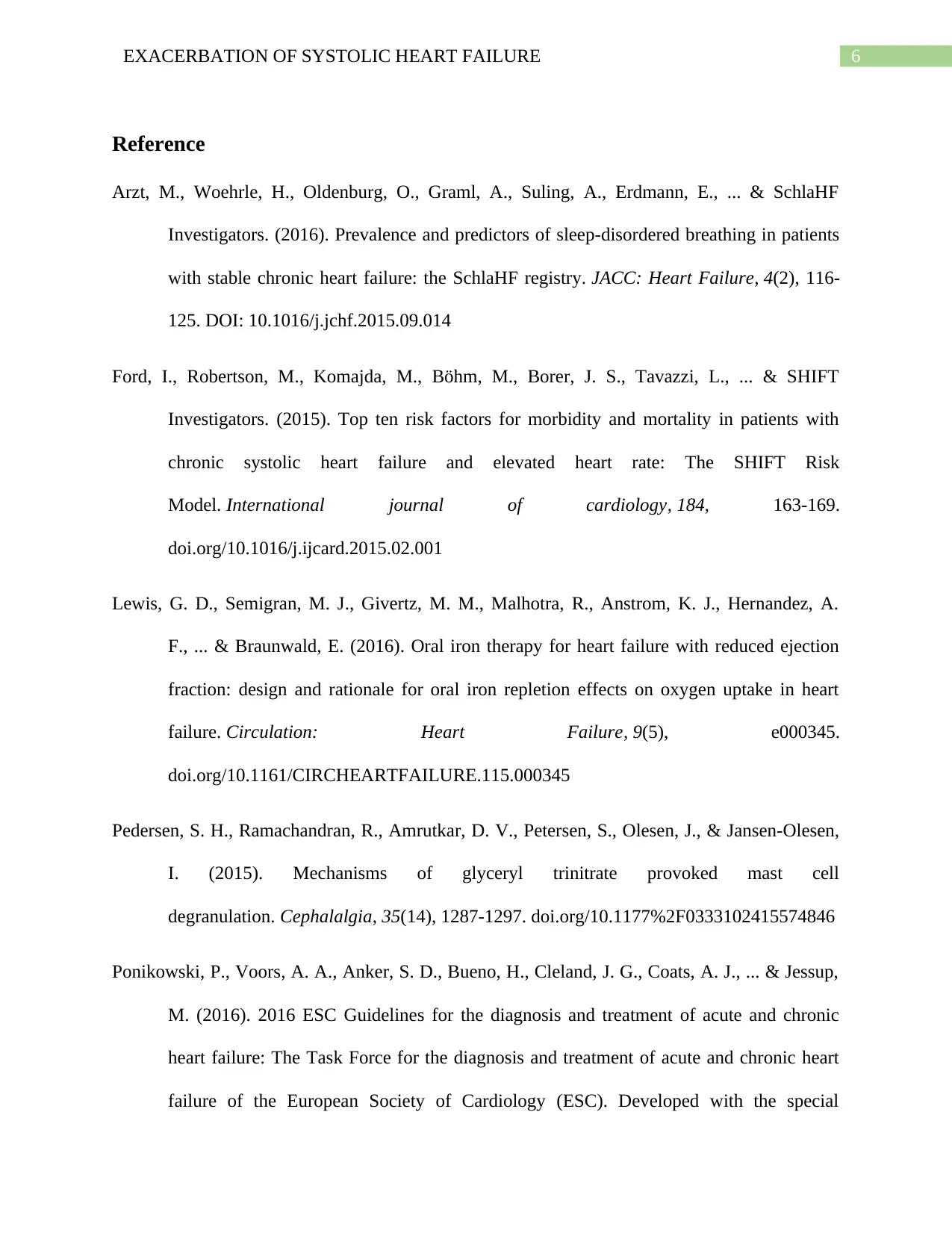
6EXACERBATION OF SYSTOLIC HEART FAILURE
Reference
Arzt, M., Woehrle, H., Oldenburg, O., Graml, A., Suling, A., Erdmann, E., ... & SchlaHF
Investigators. (2016). Prevalence and predictors of sleep-disordered breathing in patients
with stable chronic heart failure: the SchlaHF registry. JACC: Heart Failure, 4(2), 116-
125. DOI: 10.1016/j.jchf.2015.09.014
Ford, I., Robertson, M., Komajda, M., Böhm, M., Borer, J. S., Tavazzi, L., ... & SHIFT
Investigators. (2015). Top ten risk factors for morbidity and mortality in patients with
chronic systolic heart failure and elevated heart rate: The SHIFT Risk
Model. International journal of cardiology, 184, 163-169.
doi.org/10.1016/j.ijcard.2015.02.001
Lewis, G. D., Semigran, M. J., Givertz, M. M., Malhotra, R., Anstrom, K. J., Hernandez, A.
F., ... & Braunwald, E. (2016). Oral iron therapy for heart failure with reduced ejection
fraction: design and rationale for oral iron repletion effects on oxygen uptake in heart
failure. Circulation: Heart Failure, 9(5), e000345.
doi.org/10.1161/CIRCHEARTFAILURE.115.000345
Pedersen, S. H., Ramachandran, R., Amrutkar, D. V., Petersen, S., Olesen, J., & Jansen-Olesen,
I. (2015). Mechanisms of glyceryl trinitrate provoked mast cell
degranulation. Cephalalgia, 35(14), 1287-1297. doi.org/10.1177%2F0333102415574846
Ponikowski, P., Voors, A. A., Anker, S. D., Bueno, H., Cleland, J. G., Coats, A. J., ... & Jessup,
M. (2016). 2016 ESC Guidelines for the diagnosis and treatment of acute and chronic
heart failure: The Task Force for the diagnosis and treatment of acute and chronic heart
failure of the European Society of Cardiology (ESC). Developed with the special
Reference
Arzt, M., Woehrle, H., Oldenburg, O., Graml, A., Suling, A., Erdmann, E., ... & SchlaHF
Investigators. (2016). Prevalence and predictors of sleep-disordered breathing in patients
with stable chronic heart failure: the SchlaHF registry. JACC: Heart Failure, 4(2), 116-
125. DOI: 10.1016/j.jchf.2015.09.014
Ford, I., Robertson, M., Komajda, M., Böhm, M., Borer, J. S., Tavazzi, L., ... & SHIFT
Investigators. (2015). Top ten risk factors for morbidity and mortality in patients with
chronic systolic heart failure and elevated heart rate: The SHIFT Risk
Model. International journal of cardiology, 184, 163-169.
doi.org/10.1016/j.ijcard.2015.02.001
Lewis, G. D., Semigran, M. J., Givertz, M. M., Malhotra, R., Anstrom, K. J., Hernandez, A.
F., ... & Braunwald, E. (2016). Oral iron therapy for heart failure with reduced ejection
fraction: design and rationale for oral iron repletion effects on oxygen uptake in heart
failure. Circulation: Heart Failure, 9(5), e000345.
doi.org/10.1161/CIRCHEARTFAILURE.115.000345
Pedersen, S. H., Ramachandran, R., Amrutkar, D. V., Petersen, S., Olesen, J., & Jansen-Olesen,
I. (2015). Mechanisms of glyceryl trinitrate provoked mast cell
degranulation. Cephalalgia, 35(14), 1287-1297. doi.org/10.1177%2F0333102415574846
Ponikowski, P., Voors, A. A., Anker, S. D., Bueno, H., Cleland, J. G., Coats, A. J., ... & Jessup,
M. (2016). 2016 ESC Guidelines for the diagnosis and treatment of acute and chronic
heart failure: The Task Force for the diagnosis and treatment of acute and chronic heart
failure of the European Society of Cardiology (ESC). Developed with the special
Paraphrase This Document
Need a fresh take? Get an instant paraphrase of this document with our AI Paraphraser
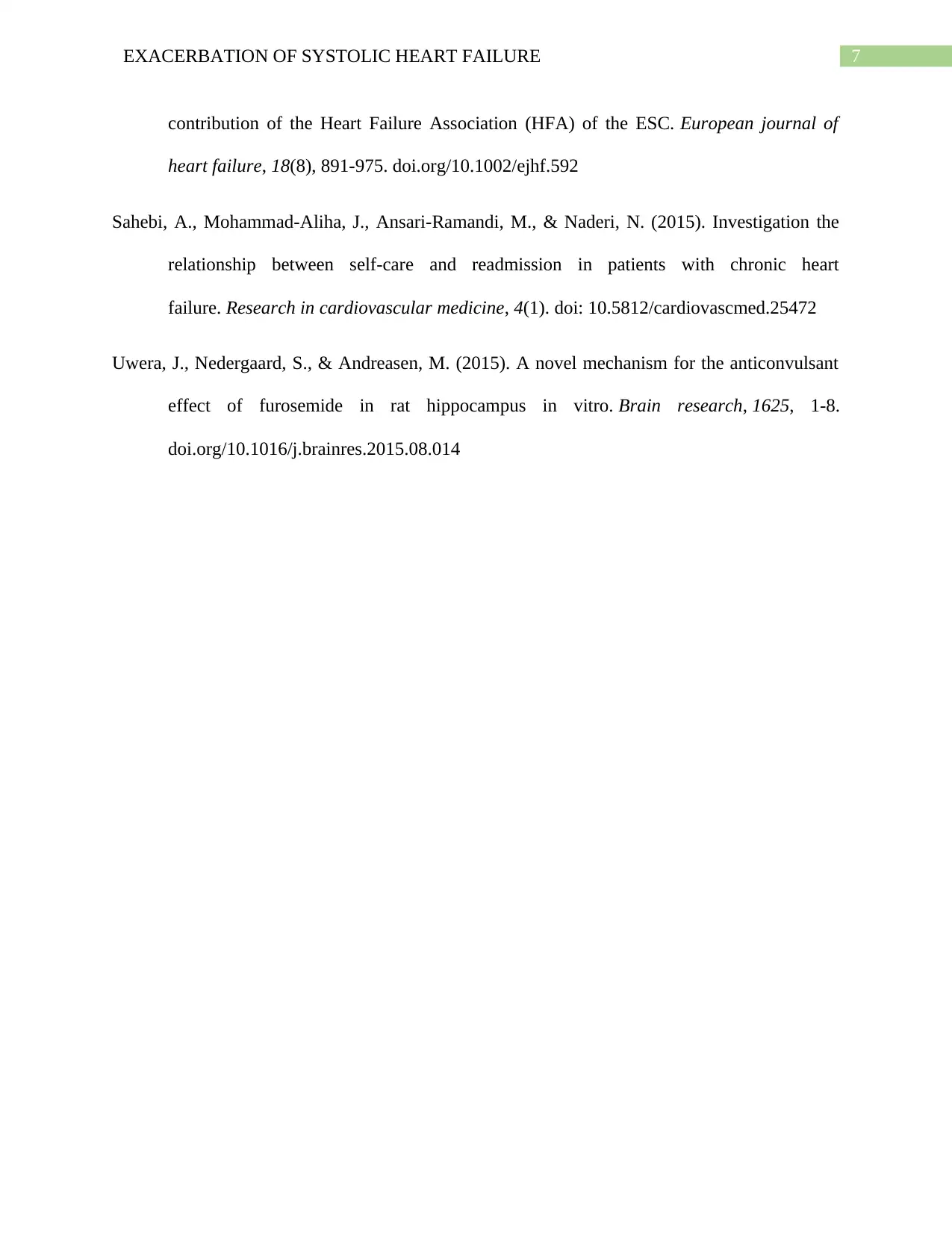
7EXACERBATION OF SYSTOLIC HEART FAILURE
contribution of the Heart Failure Association (HFA) of the ESC. European journal of
heart failure, 18(8), 891-975. doi.org/10.1002/ejhf.592
Sahebi, A., Mohammad-Aliha, J., Ansari-Ramandi, M., & Naderi, N. (2015). Investigation the
relationship between self-care and readmission in patients with chronic heart
failure. Research in cardiovascular medicine, 4(1). doi: 10.5812/cardiovascmed.25472
Uwera, J., Nedergaard, S., & Andreasen, M. (2015). A novel mechanism for the anticonvulsant
effect of furosemide in rat hippocampus in vitro. Brain research, 1625, 1-8.
doi.org/10.1016/j.brainres.2015.08.014
contribution of the Heart Failure Association (HFA) of the ESC. European journal of
heart failure, 18(8), 891-975. doi.org/10.1002/ejhf.592
Sahebi, A., Mohammad-Aliha, J., Ansari-Ramandi, M., & Naderi, N. (2015). Investigation the
relationship between self-care and readmission in patients with chronic heart
failure. Research in cardiovascular medicine, 4(1). doi: 10.5812/cardiovascmed.25472
Uwera, J., Nedergaard, S., & Andreasen, M. (2015). A novel mechanism for the anticonvulsant
effect of furosemide in rat hippocampus in vitro. Brain research, 1625, 1-8.
doi.org/10.1016/j.brainres.2015.08.014
1 out of 8
Related Documents
Your All-in-One AI-Powered Toolkit for Academic Success.
+13062052269
info@desklib.com
Available 24*7 on WhatsApp / Email
![[object Object]](/_next/static/media/star-bottom.7253800d.svg)
Unlock your academic potential
Copyright © 2020–2025 A2Z Services. All Rights Reserved. Developed and managed by ZUCOL.





